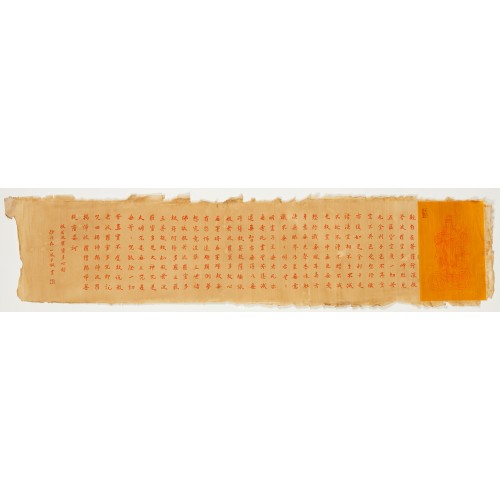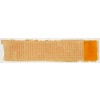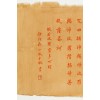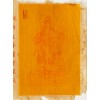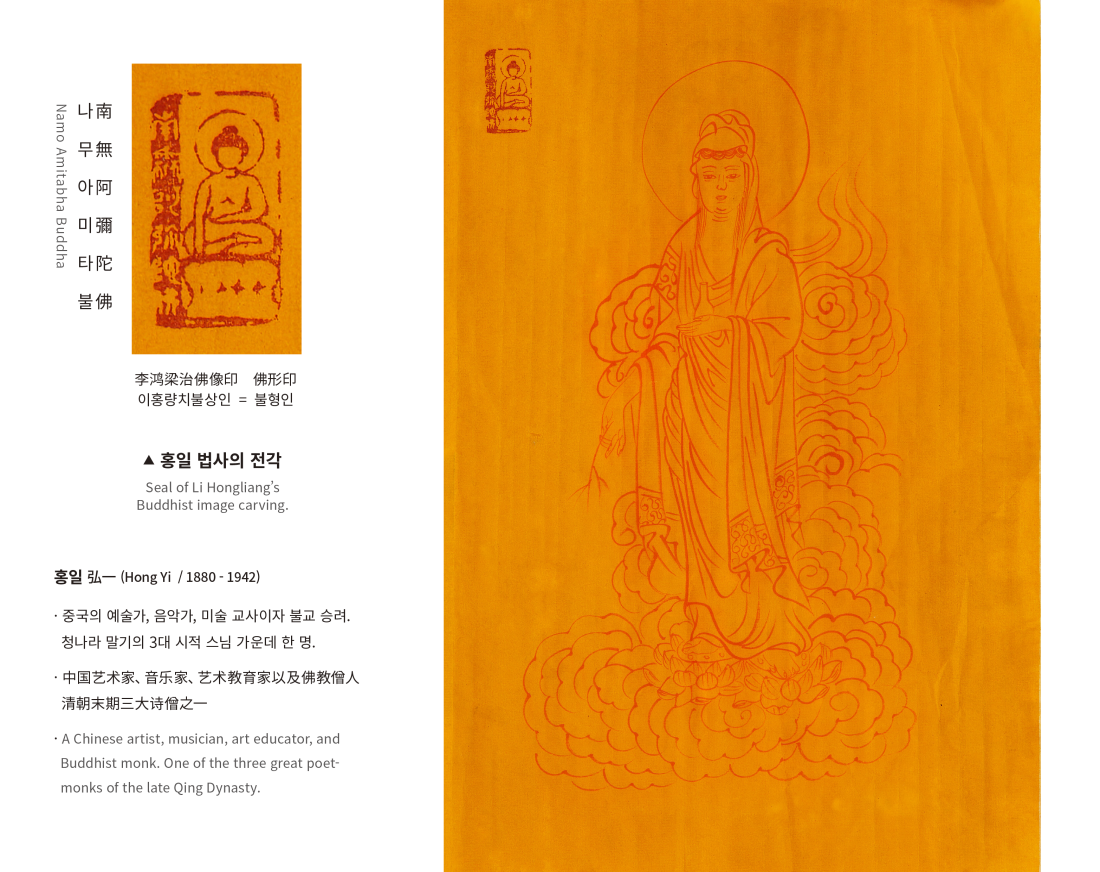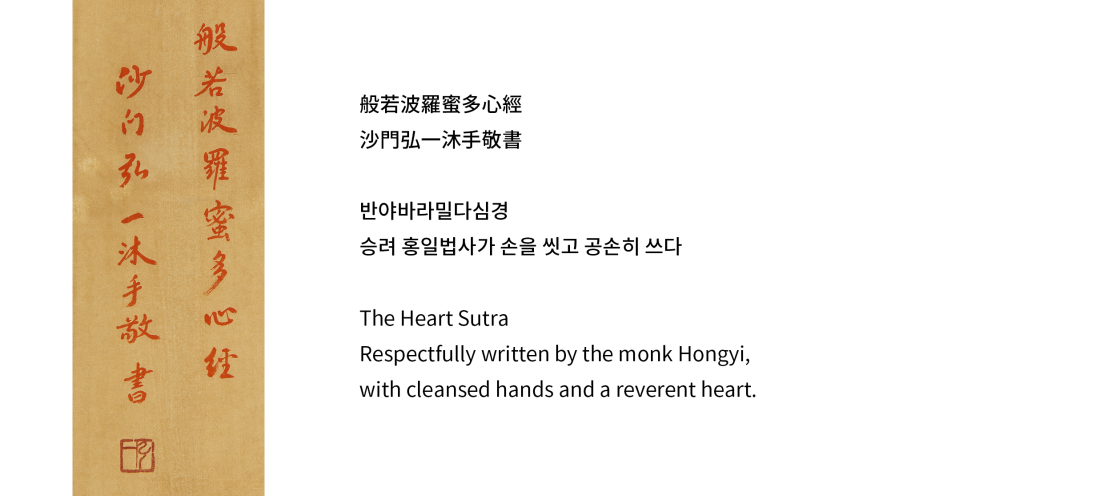본문
홍일법사가 글을 적은 반야바라밀다심경입니다.
줄여서 반야심경은 대승불교의 핵심 경전으로, 총 600권에 달하는 반야경(般若經)을 단 260자로 간략히 정리한 것입니다.
경문의 형식은 관세음보살이 사리불(舍利弗)에게 수행법을 설파하는 구조로 되어 있습니다.
현재 전해지는 반야심경은 당나라 삼장법사 현장(玄奘, 602~664)이 번역한 것입니다.
유물은 두루마리 형식으로 화면의 오른편에 관세음보살이 주사 선묘로 그려져 있습니다.
관세음보살은 고통받는 중생들의 소리를 보고 그들을 구원하기 위해 자비를 베푸는 보살입니다.
그림에서 관세음보살은 왼손에 정병을 들고 오른손에 버들가지를 쥐고 있는 모습으로 표현되었으며, 연꽃 위에 올라서 구름을 타고 내려오는 모습으로 묘사되었습니다.
관세음보살이 들고 있는 정병은 감로수나 깨끗한 물을 담는 병으로 스님들의 공양구 중 하나입니다.
감로수는 중생의 고통과 갈증을 해소해주는 이슬이라는 의미로 이를 담는 정병은 자비를 나타냅니다. 버들가지는 병자에게 정병 안의 물을 뿌려 병을 낫게 하는 데 사용됩니다.
그림 왼편으로 행서체의 반야심경이 적혀있으며 홍일법사의 낙관이 있습니다.
▣ 홍일법사 (弘一法師) (1880~1942)
1880년, 중국 톈진에서 관공서 일을 맡던 거상(鉅賈)의 집안에서 태어났습니다.
22세에 상하이 남양공학에 입학하였고, 26세에 일본으로 유학을 떠났으며, 32세에 중국으로 돌아와 톈진공업대학에서 교직을 맡았습니다.
1916년에는 항저우 서호에 있는 정혜사(虎跑定慧寺)에 들어갔고, 1918년(39세)에 출가하여 승려가 되었습니다.
법명은 인음(寅音), 법호는 홍일(弘一)이며, 속명은 이숙동(李叔同)으로 알려져 있습니다.
그는 중국에서 최초로 서양 회화를 도입한 인물이며, 처음으로 오선지를 사용해 음악 교육을 실시한 사람입니다.
또한, 중국 최초의 화극사를 설립하는 등 예술 분야에서 선구적인 역할을 했습니다. 음악, 서예, 회화, 희극 등 다양한 방면에 깊은 조예를 지녔으며, 생애 중 50년 이상을 서예와 함께했습니다.
현대 서예가들 중에서도 그만큼 열정적으로 서예의 길을 걸었던 이는 드물며, 말년에는 자신만의 독창적인 서체를 남겼습니다.
그의 작품은 중국 서예 예술사에서 탁월한 성과로 평가받고 있습니다.
그는 모든 사람에게 '홍일 스승'으로 알려졌으며, 1942년에 복건성 천주시에서 61세의 나이로 평화롭게 세상을 떠났습니다. 홍일법사는 청나라 말기의 3대 시적 스님(시승 詩僧, 시에 능한 승려) 중 한명입니다. (다른 사람들은 수만수, 시정간입니다)
━━━━━
本作品为弘一法师所书写的《般若波罗蜜多心经》。
简称《般若心经》,是大乘佛教的核心经典之一,将达600卷的《般若经》浓缩为仅260字,精炼地传达了“般若智慧”的精髓。
此经文以观世音菩萨的修行体悟,向舍利弗进行讲解的形式展开。 现存通行版本为唐代三藏法师玄奘(602–664年)所翻译。
此件作品为卷轴形式,画面右侧描绘了以朱砂细笔绘制的观世音菩萨形象。观世音菩萨是倾听世间众生疾苦之声、施以慈悲救度的菩萨。
画中,观世音菩萨左手持净瓶,右手握柳枝,脚踏莲花,乘祥云而降。
净瓶为僧侣所用供具之一,用以盛放甘露或清水,象征净化与慈悲;“甘露”意为解除众生痛苦与渴望的甘露之水。柳枝则用于将净瓶中的水洒向病患,以祈愿其病痛痊愈。
画面左侧以行书完整书写《般若心经》,并有弘一法师的印章。
▣ 弘一法師 (1880~1942)
1880年出生于天津一官宦富商之家。
22岁时,他进入上海南洋公学学习,26岁时赴日本留学,32岁时回国并在天津工业大学任教。
1916年,他进入杭州西湖附近的虎跑寺,并于1918年(39岁)出家,成为一名僧侣。
法名演音,号弘一,俗名李叔同。
他是中国最早引入西洋绘画的人,也是首位使用五线谱进行音乐教学的人。
此外,他还在中国创办了第一所话剧学校等,成为艺术领域的开创者之一。
他在音乐、书法、绘画、戏剧等多个领域都有深厚的造诣,并且在生命中,有超过50年都在致力于书法。
即使在现代书法家中,像这样充满热情地走上书法之路的人也极为罕见,他在晚年创作了自己独特的书法风格。
他的作品被认为是中国书法艺术史上的杰出成就。
━━━━━
This is the Heart Sutra transcribed by the Buddhist monk Hongyi.
Commonly known as the Heart Sutra, it is a core scripture in Mahāyāna Buddhism, offering a concise summary of the Prajñāpāramitā Sūtras—a voluminous body of scriptures totaling around 600 volumes—using only 260 characters.
The sutra is structured as a dialogue in which the bodhisattva Avalokiteśvara expounds the practice of wisdom to the disciple Śāriputra.
The version preserved today was translated by the Tang Dynasty monk Xuanzang (玄奘, 602–664).
This artifact is in scroll format. On the right side of the scroll, Avalokiteśvara Bodhisattva is depicted in red lines.
Avalokiteśvara is the bodhisattva of compassion who listens to the cries of suffering beings and offers salvation.
In the illustration, the bodhisattva is shown holding a purification flask in the left hand and a willow branch in the right.
Standing on a lotus, the figure descends on clouds—a visual metaphor for descending to the suffering world.
The flask, used by monks in rituals, contains sweet dew or pure water. It symbolizes compassion, as sweet dew is said to quench suffering and thirst.
The willow branch is used to sprinkle this water upon the sick for healing purposes.
To the left side of the scroll, the Heart Sutra is inscribed in semi-cursive script. At the end, Hongil's signature and seal are included, indicating the scribe's reverent intent.
▣ Hong Yi Dharma Master (弘一法師) (1880~1942)
Hong Yi Dharma Master was born in 1880 into a wealthy merchant family engaged in government affairs in Tianjin, China.
At the age of 22, he entered Nanyang Public School in Shanghai.
At 26, he went to Japan for further studies, and at 32, he returned to China to take a teaching position at Tianjin Industrial University.
In 1916, he entered Dinghui Temple (虎跑定慧寺) at West Lake in Hangzhou.
In 1918, at the age of 39, he became a monk and was given the Dharma name Yin Yin (寅音), with the monastic title Hong Yi (弘一). His birth name was Li Shutong (李叔同).
He was the first person to introduce Western painting to China and the first to use staff notation in music education.
Additionally, he established the first modern Chinese drama society, making significant contributions to the arts.
He excelled in various fields, including music, calligraphy, painting, and theater. Throughout his life, he devoted more than 50 years to calligraphy.
Few modern calligraphers have pursued the art as diligently as he did.
In his later years, he developed a unique and original calligraphic style, which is regarded as an outstanding achievement in the history of Chinese calligraphy.
He was known to everyone as "Master Hong Yi" and peacefully passed away in 1942 in Quanzhou, Fujian Province, at the age of 61. Hong Yi Dharma Master is regarded as one of the three great poet-monks of the late Qing Dynasty. (The others are Su Manshu and Shi Jingan.)
